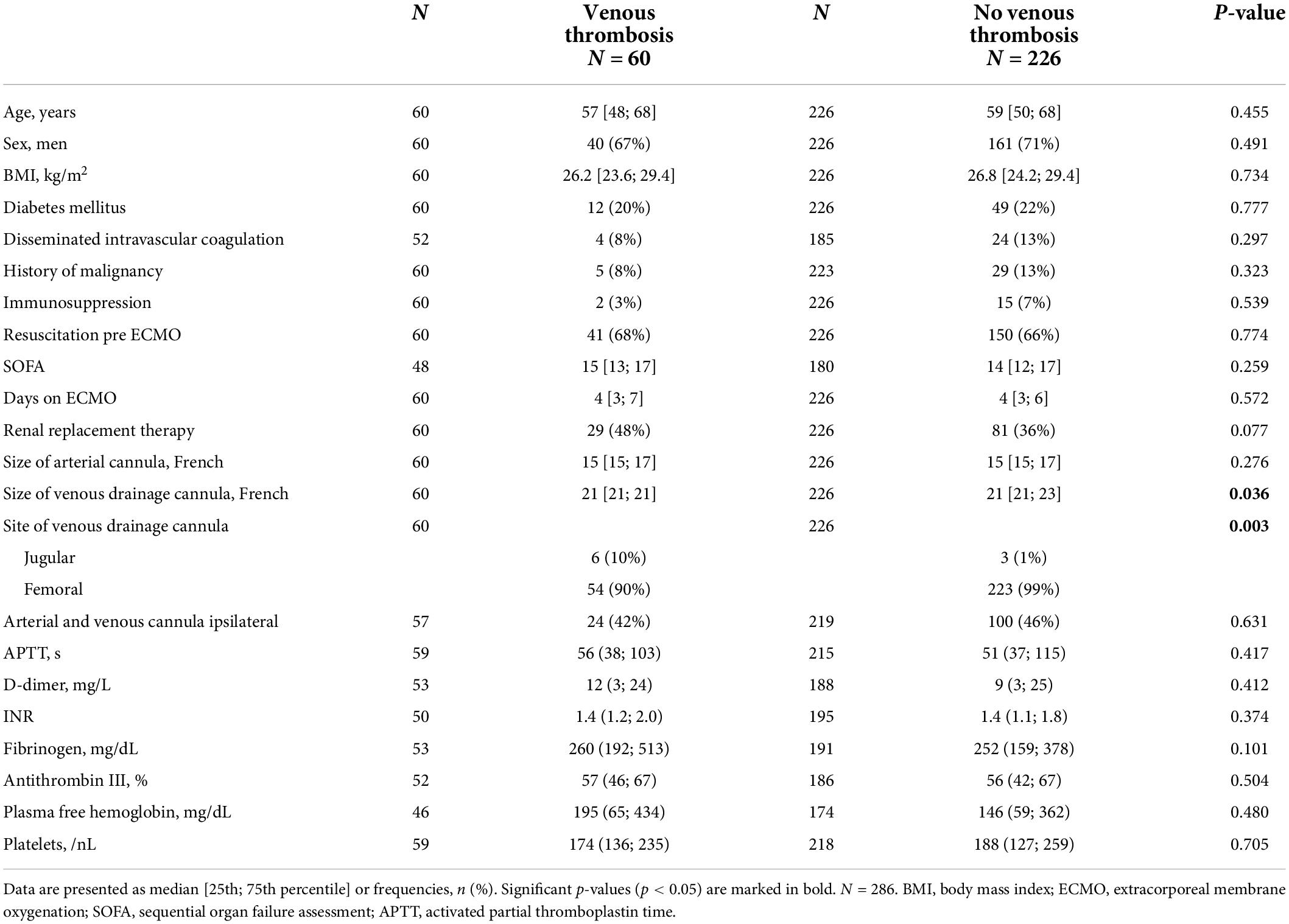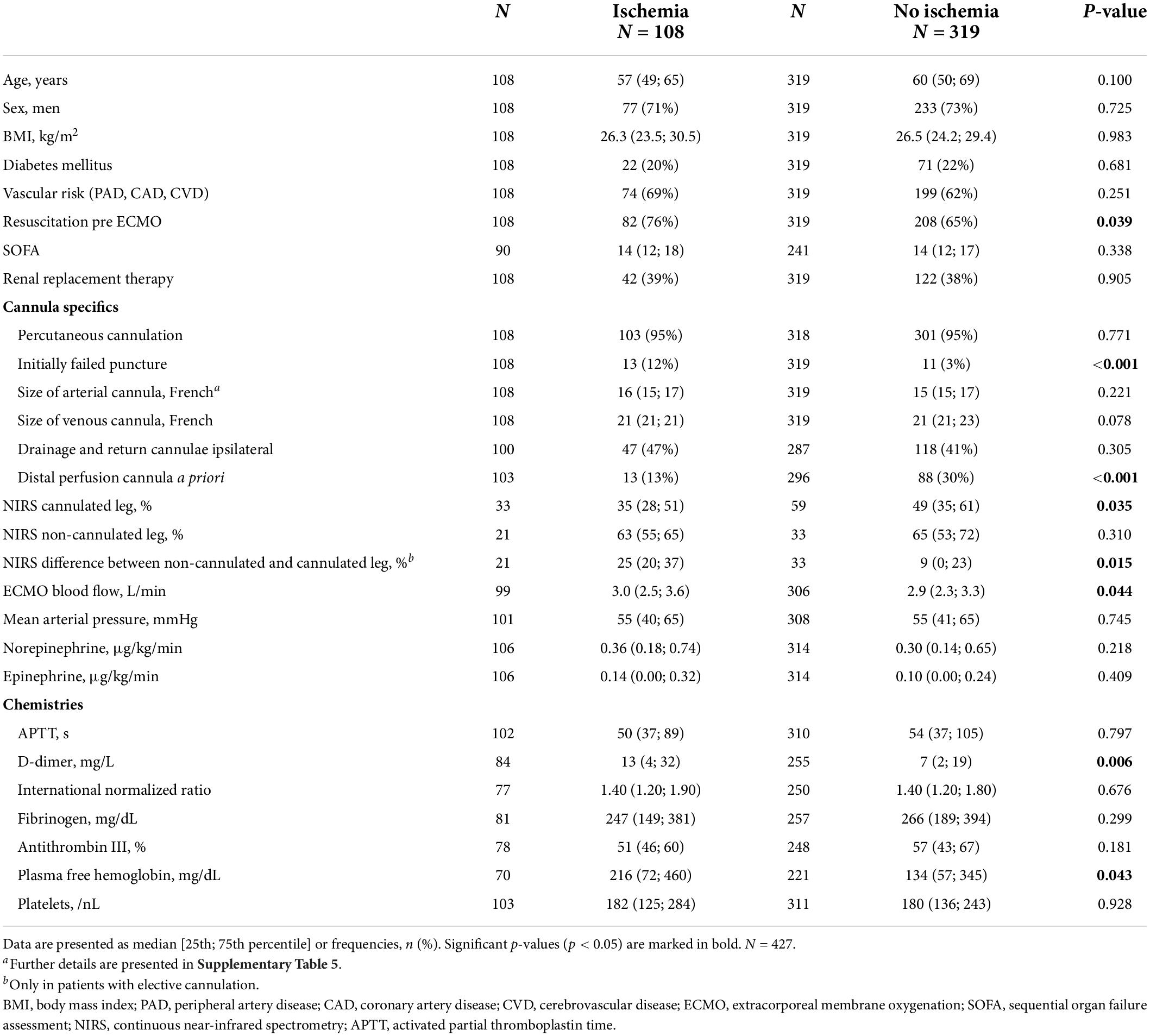- 1Department of Internal Medicine II, University Hospital Regensburg, Regensburg, Germany
- 2Department of Cardiothoracic Surgery, University Hospital Regensburg, Regensburg, Germany
- 3Department of Anesthesiology, University Hospital Regensburg, Regensburg, Germany
- 4Department of Vascular Surgery, University Hospital Regensburg, Regensburg, Germany
Introduction: The aim of this study was to investigate the prevalence of arterial and venous complications in patients requiring peripheral venoarterial extracorporeal membrane oxygenation (VA ECMO) and its risk factors at the time of cannulation and during extracorporeal membrane oxygenation (ECMO) support and to assess vascular complications in association with decannulation.
Material and methods: Between January 2010 to January 2020, out of 1,030 eligible patients requiring VA-ECMO, 427 with analyzable vascular screening were included. Duplex sonography and/or CT scan after decannulation were used to screen for thrombosis and pulmonary embolism as well as arterial complications. Near-infrared spectrometry (NIRS) was established at the time of cannulation and was continuously monitored during the ECMO therapy.
Results: The prevalence of venous complications was 27%. Thrombosis and pulmonary embolism were observed in 21 and 7% of patients, respectively. Pulmonary embolism was more frequently diagnosed in patients with thrombosis (22 vs. 3%, p < 0.001). In multivariate analysis, cannulation in the jugular vein was determined as a risk factor for venous thrombosis in contrast to the extent of anticoagulation. The prevalence of arterial complications was 37%, mainly ischemia followed by bleeding, dissection, and compartment syndrome. Vascular surgery was necessary for 19% of the patients, of whome 1% required major amputations. A distal perfusion cannula (DPC) was implanted at cannulation in 24% of patients and secondarily in 16% of patients after cannulation as required during ECMO support. In the multivariate analysis, risk factors for leg ischemia at the time of cannulation were elevated D-dimers, lower NIRS on the cannulated leg, and lack of a DPC. The best discriminative parameter was the difference in NIRS between the non-cannulated leg and the cannulated leg. In contrast, during ECMO support, only the lack of a DPC was associated with leg ischemia. A similar rate of complications associated with decannulation, mainly arterial thrombosis, ischemia, or bleeding, was seen with percutaneous and surgical approaches (18 vs. 17%, p = 0.295).
Conclusion: Patients requiring VA ECMO should be routinely screened for vascular complications. The decision to insert a DPC should be evaluated individually. However, NIRS monitoring of the cannulated leg and the non-cannulated leg is essential to identify the legs at risk for critical ischemia. As complications associated with decannulation were equally distributed between percutaneous and surgical approaches, the applied method may be chosen according to local experience.
Introduction
Despite technological improvements and increasing clinical experience with venoarterial extracorporeal membrane oxygenation (VA ECMO), significant complications arise during VA-ECMO therapy either due to the therapy itself or due to the complexity of the critically ill patient.
A frequent complication in venovenous (VV) ECMO is thromboembolism, affecting more than 50% of patients to various extents (1). In contrast to the extensive knowledge available on VV ECMO, remarkably little is known about venous complications such as thrombosis and pulmonary embolism in patients requiring VA ECMO. This lack of knowledge is even more surprising considering the fact that patients requiring VA ECMO are more severely ill than patients requiring VV ECMO (2). For instance, patients requiring VA ECMO more frequently present with liver failure, which may affect coagulation, and often need different anticoagulation strategies than patients with VV ECMO support (3).
A distinct feature of peripheral VA ECMO in comparison to VV ECMO is the cannulation of a major artery, which is frequently accompanied by arterial vascular complications such as critical limb ischemia (4). It is known that critical limb ischemia during VA ECMO is associated with increased demands on medical resources, lower quality of life, and poor outcomes (5). Further, arterial vascular complications, such as bleeding, dissection, compartment syndrome, or initially failed puncture, and complications in association with decannulation are seldomly reported and need to be more emphasized.
Therefore, the aim of this study was to investigate the prevalence of arterial and venous vascular complications in patients requiring peripheral venoarterial extracorporeal membrane oxygenation (VA ECMO) and its risk factors at the time of cannulation and during ECMO support and to assess the complications in association with decannulation.
Materials and methods
Study subjects
All consecutive adult patients supported with VA ECMO at the University Hospital Regensburg between January 2010 and January 2020 were eligible for this analysis. Patients who had received central VA ECMO cannulation or had died during the ECMO therapy were excluded because screening for vascular complications after decannulation was not conducted in these patients.
Indications for VA ECMO were the cardiogenic shock of different etiologies and extracorporeal cardiopulmonary resuscitation (eCPR).
The study was conducted according to the Declaration of Helsinki on Good Clinical Practice. The requirement of individual patient consent and the necessity of approval for the data report were waived by the local ethics committee (20-1710-104) because of the retrospective, anonymized study design and of the analysis of data exclusively collected during routine care.
Patient data such as demographics, biochemistry, hemodynamic parameters, resuscitation status, sequential organ failure assessment (SOFA), and computed tomography images were extracted from the electronic patient data management system. The preexisting vascular risk status was defined according to the diagnosis of cerebrovascular disease (CVD), peripheral artery disease (PAD), or coronary artery disease (CAD). Disseminated intravascular coagulopathy was defined as that stated in a previous study (1), with good neurologic outcome as a cerebral performance score (CPC) of 1 (good cerebral performance) or 2 (moderate disability) and poor neurologic outcome as a CPC of 3–5 (6). Survival was assessed at discharge from the hospital.
Cannulation and decannulation technique and anticoagulation
In general, drainage cannulae were placed into the femoral vein and return cannulae into the femoral artery either on the same side (mainly during eCPR) or bilaterally. Adaptions were allowed according to the anatomy or the treating physician. The drainage and the return cannulae were implanted percutaneously via Seldinger’s technique by an experienced intensivist or in the operation room by a surgeon. A vascular ultrasound scan was carried out prior to cannulation when possible. The size of the arterial and venous cannulae was chosen as previously published according to ultrasound findings, the desired ECMO flow rate, and the patients’ physical dimensions (4). The position of the cannulae was checked with ultrasound and x-ray or CT scan. Patients without any previous therapeutic anticoagulation received a bolus of up to 5,000 IU unfractionated heparin for cannulation. The circuit design and components of cannulation are depicted in Supplementary Figure 1.
During ECMO support, we aimed for an activated partial thromboplastin time of 60 ± 5 s in accordance with current recommendations (3). Further details on anticoagulation have been previously published (1, 4) and are presented in Supplementary Table 1.
A distal wire-reinforced perfusion cannula (DPC, CruraSave femoral-Perfusion Set 7 Fr, Free life medical GmbH, Aachen, Germany) into the superficial femoral artery was not routinely inserted (Supplementary Figure 2). The placement of a DPC was usually made in the ICU in the case of clinical signs of reduced leg perfusion at the time of cannulation or during the ECMO therapy. The flow rate of the DPC was checked routinely every 8–24 h and more frequently in case of a decline in near-infrared spectrometry (NIRS) (4).
Decannulation was performed either percutaneously with manual compression at the bedside or by surgeons in the operating theater after discontinuation of anticoagulation for at least 4 h. After control of bleeding by manual compression and skin suture, an inflatable balloon tape system (SafeGuard; MeritEMEA, Limburg, The Netherlands) was attached for at least 24 h. The balloon device was stepwise deflated every 2–4 h until complete removal. Alternatively, a compression bandage was applied.
Venous complications
Screening for venous thrombosis was conducted with duplex sonography within 3 days after decannulation. The diagnosis was made by specially trained physicians in the case of incompressible veins and absent or reduced blood flow as indicated in a previously study (1, 7). Obstruction of the venous lumen diameter of >50% was classified as major thrombosis (1, 7). Additionally, all available CT scans made for various clinical indications after decannulation during the hospital stay were analyzed for new events of pulmonary embolism and thrombosis (1). Additionally, we assessed other complications such as bleeding at the site of cannulation, atrial/ventricular perforation, and compartment syndrome that might occur in parallel to thromboembolic complications.
Arterial complications
Risk factors for limb ischemia were collected from the initiation until the end of ECMO support. Regional oxygen saturation in both legs was continuously measured by NIRS (INVOS™ 5100C, Medtronic, Minneapolis, United States). For the analysis of the entire ECMO support, NIRS was documented only one time a day, i.e., in the morning. Acute desaturation in NIRS as a sign of deterioration of perfusion/ischemia immediately resulted in further diagnostic workup and intervention to prevent limb ischemia (e.g., placement of a DPC). In addition, clinical signs of arterial complications of the leg (pallor, hypothermia, or pulselessness) or bleeding were checked routinely every 2 h. Doppler ultrasonography of the dorsalis pedis artery and the posterior tibial artery was routinely performed every 8 h and more frequently in the case of suspected ischemia. If possible, preventive measures to reduce the risk of limb ischemia such as improvement of leg perfusion were applied by means of reduction of vasopressors, infusion of vasodilators, or use of inotropes. In the case of incipient limb ischemia of a cannulated leg without a primarily implanted DPC, a DPC was inserted with the guidance of ultrasound.
Based on previous publications, critical limb ischemia was defined as a decrease in NIRS by 25% compared to the contralateral leg, a decrease in absolute NIRS values below 40%, showing clinical signs of ischemia, or showing sonographic evidence of missing perfusion (4). Additionally, we assessed other complications such as arterial thrombosis, bleeding at the site of cannulation, arterial dissection, compartment syndrome, and vascular surgery. Moreover, physicians’ documentation (including surgical protocols) and nurses’ shift reports were screened for vascular complications.
Miscellaneous complications and complications associated with decannulation
Complications that could not be assigned to either the venous or arterial vascular system with certainty were considered miscellaneous complications, which included bleeding at the site of cannulation, arteriovenous fistula, and initially failed puncture during cannulation. We also assessed complications in association with decannulation such as ischemia, compartment syndrome, pseudoaneurysm, and bleeding.
Statistics
All quantitative data are expressed as median (interquartile range) and were compared with the Mann–Whitney-U test. Differences between the study groups were assessed with the Chi-squared test of independence for nominal variables or the Fisher’s exact test as needed. Univariate logistic regression models were conducted to identify risk factors for venous thrombosis or limb ischemia. For limb ischemia, one model included parameters at the time of cannulation and the other model included parameters assessed during the ECMO therapy. The multivariat logistic regression model was adjusted for alle factors with a p values of less than 0.1 in the univariate analysis. In addition, a multivariate model for biochemistries according to limb ischemia was calculated. The cutoff points for NIRS were identified by receiver operating characteristic (ROC) analysis using the Youden index. All reported p-values were two-sided, and a p-value of ≤ 0.05 was considered statistically significant. Data entry and calculation were done using Microsoft EXCEL365 ProPlus (Microsoft, Redmond, WA, United States) and IBM SPSS Statistic software version 25.0 (SPSS Inc., Chicago, IL, United States).
Results
Study population
From January 2010 to January 2020, 1,030 patients required VA ECMO at the University Hospital Regensburg, Germany, of whom 427 were eligible for the evaluation of venous and arterial complications (Figure 1). Patients had a median age of 59 [50; 68] years, a body mass index of 26.5 [24.2; 29.4] kg/m2, and were mainly men (73%); 64% of patients had arteriosclerosis and 22% had diabetes mellitus. Of the 427 patients, 161 (38%) of them received cannulation during eCPR (Supplementary Table 2). The SOFA score was 14 [12; 17], and 161 (38%) of the patients required renal replacement therapy. A DPC was implanted at cannulation in 101 (24%) patients and secondarily in 66 (16%) patients after cannulation as required during ECMO support. Baseline characteristics are summarized in Supplementary Table 3.
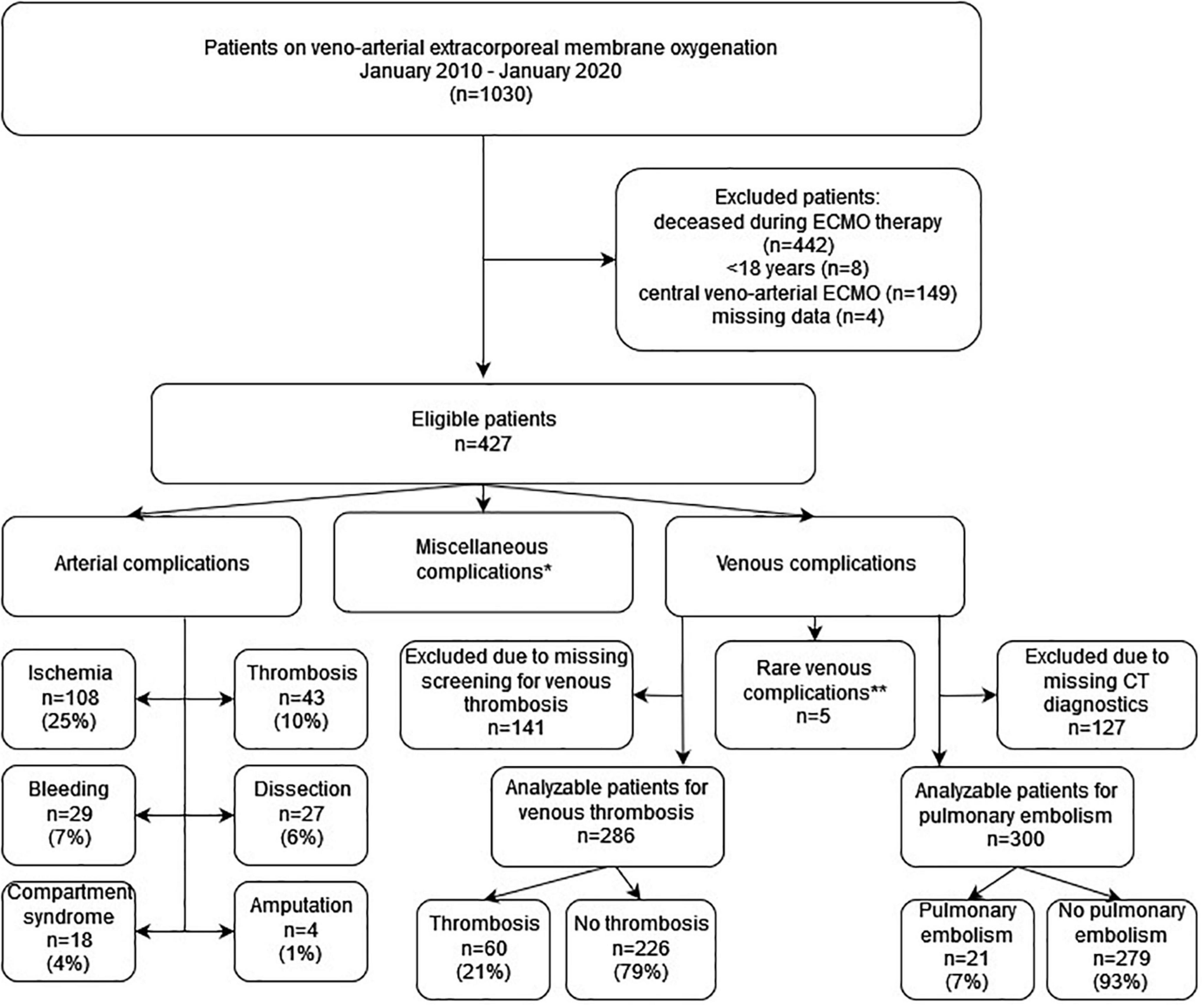
Figure 1. Flowchart of the observational study evaluating arterial and venous complications in survivors of venoarterial extracorporeal membrane oxygenation of the extracorporeal life support registry at Regensburg; ECMO, extracorporeal membrane oxygenation; CT, computer tomography; *miscellaneous complications included initially failed puncture (n = 24), bleeding (n = 20), and arteriovenous fistula (n = 1); **rare venous complications included bleeding (n = 2), right atrial/ventricular wall perforation (n = 2), and compartment syndrome of the leg with venous cannulation (n = 1).
Venous complications
Screening for venous thrombosis was conducted in 67% (286/427) of patients. Venous thrombosis was prevalent in 21% (60/286) of patients and occlusion of the lumen diameter of > 50% was observed in 10% (29/286) of patients (Figure 2). After decannulation, thoracic CT scans with contrast dye were performed in 70% (300/427) of patients, of whom 7% (21/300) had pulmonary embolism. Pulmonary embolism was more frequently observed in those with thrombosis than those without thrombosis (22% [11/51] vs. 3% [5/168], p < 0.001). Overall, venous complications in patients undergoing screening for both pulmonary embolism and thrombosis were seen in 27% (60/219) of patients, including thromboembolic events in 26% (56/219) of them and other venous complications, such as bleeding at cannulation site (n = 2), right atrial/ventricular wall perforation (n = 2), and compartment syndrome of a leg with bilateral cannulation as a consequence of venous congestion (n = 1). Patients may have developed more than one complication.
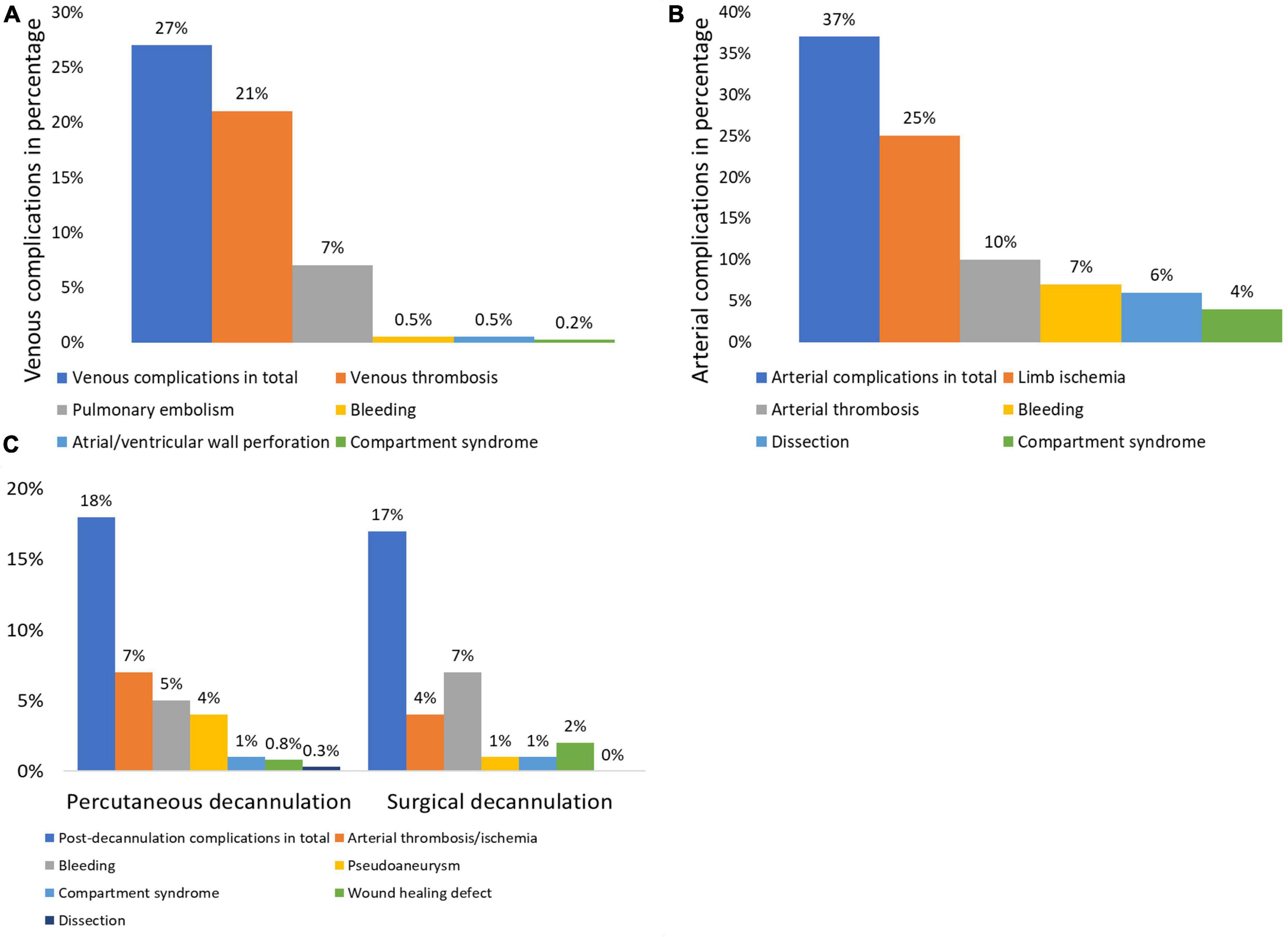
Figure 2. Prevalences of venous (A) and arterial (B) complications and (C) post-decannulation complications according to the type of decannulation in patients requiring venoarterial extracorporeal membrane oxygenation. Data are presented in percentages. All p-values comparing percutaneous vs. surgical decannulation are >0.05.
Risk factors for venous thrombosis
Risk factors for venous thrombosis were cannulation in the jugular vein in comparison to the femoral vein and the use of a small-sized cannula for venous drainage, but the latter did not occur after correcting for body surface area (Table 1 and Supplementary Table 4). Venous thrombosis was associated neither with unilateral arterial and venous cannulations nor with biochemistries (Table 2).
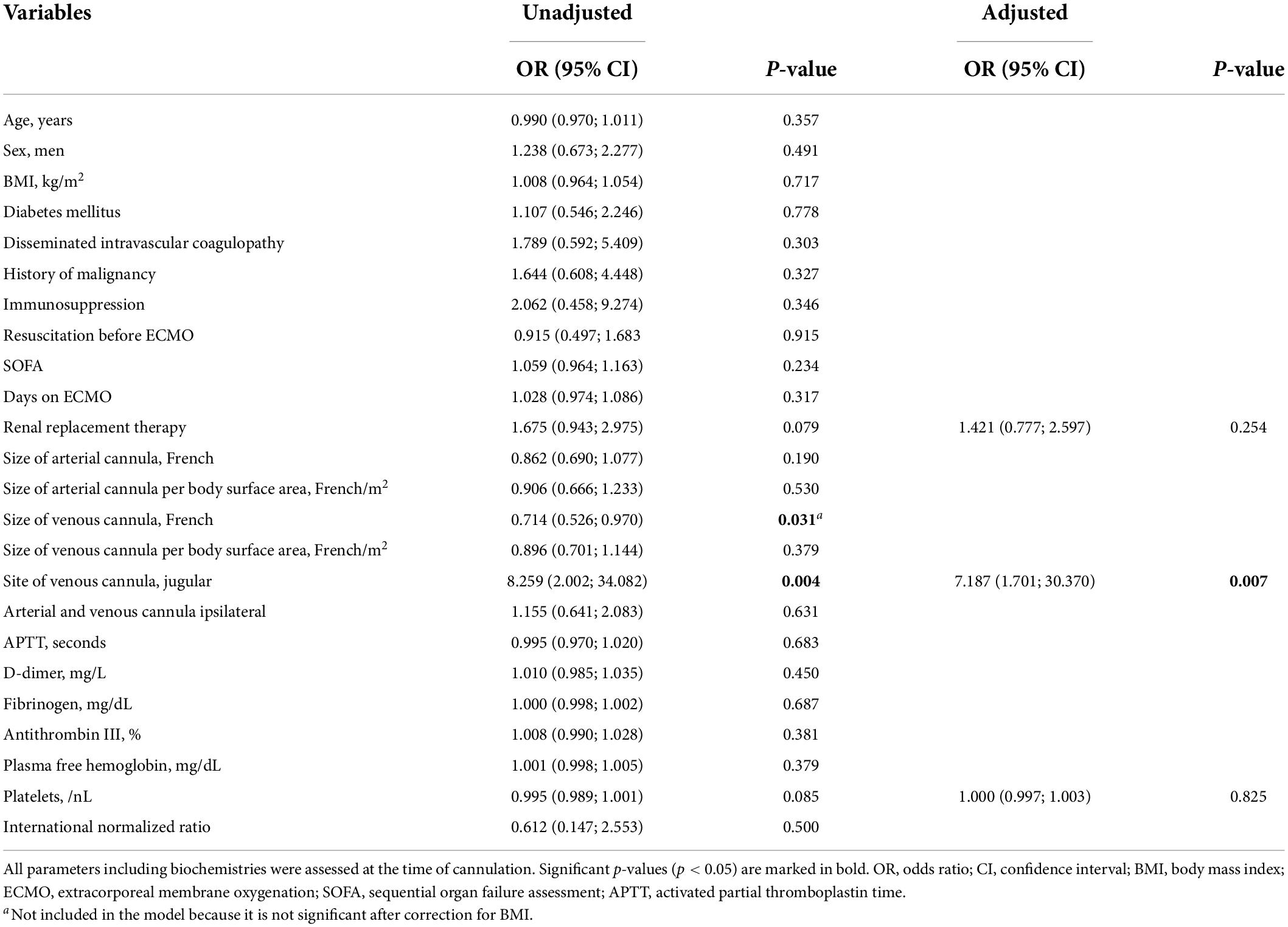
Table 2. Univariate and multivariate binary logistic regression models for venous thrombosis in survivors of venoarterial extracorporeal membrane oxygenation.
Arterial complications
Complications associated with arterial cannulation were seen in 37% (158/427) of patients during ECMO support. Patients may have developed more than one complication; thus, limb ischemia was diagnosed in 25% (108/427) of patients, arterial thrombosis in 10% (43/427), bleeding in 7% (29/427), arterial dissection in 6% (27/427), and compartment syndrome in 4% (18/427). As a consequence, vascular surgery was performed in 19% (82/427) of patients, of whom 1% (4/427) required major amputation.
Risk factors for limb ischemia at time of cannulation
Patients with limb ischemia were more frequently resuscitated, less frequently received a DPC, had lower NIRS at the cannulated and higher absolute differences in NIRS between the cannulated leg and the non-cannulated leg at the time of cannulation, and had slightly higher ECMO flow rate. No differences between the groups with and without limb ischemia were seen according to unilateral compared to bilateral cannulation, cannula size, or vasopressor therapy (Table 3). At the time of cannulation, the statistically best predictive NIRS value for limb ischemia was 18% (sensitivity 93%, specificity 18%) on the cannulated leg (Supplementary Figure 3). When comparing the difference between the non-cannulated leg and the cannulated leg with regard to limb ischemia, an absolute NIRS difference of 17% resulted in a sensitivity of 82% and a specificity of 60% (Supplementary Figure 4). In multivariate analysis, lack of a DPC, lower NIRS in the cannulated leg, and elevated D-dimers were associated with limb ischemia (Table 4).
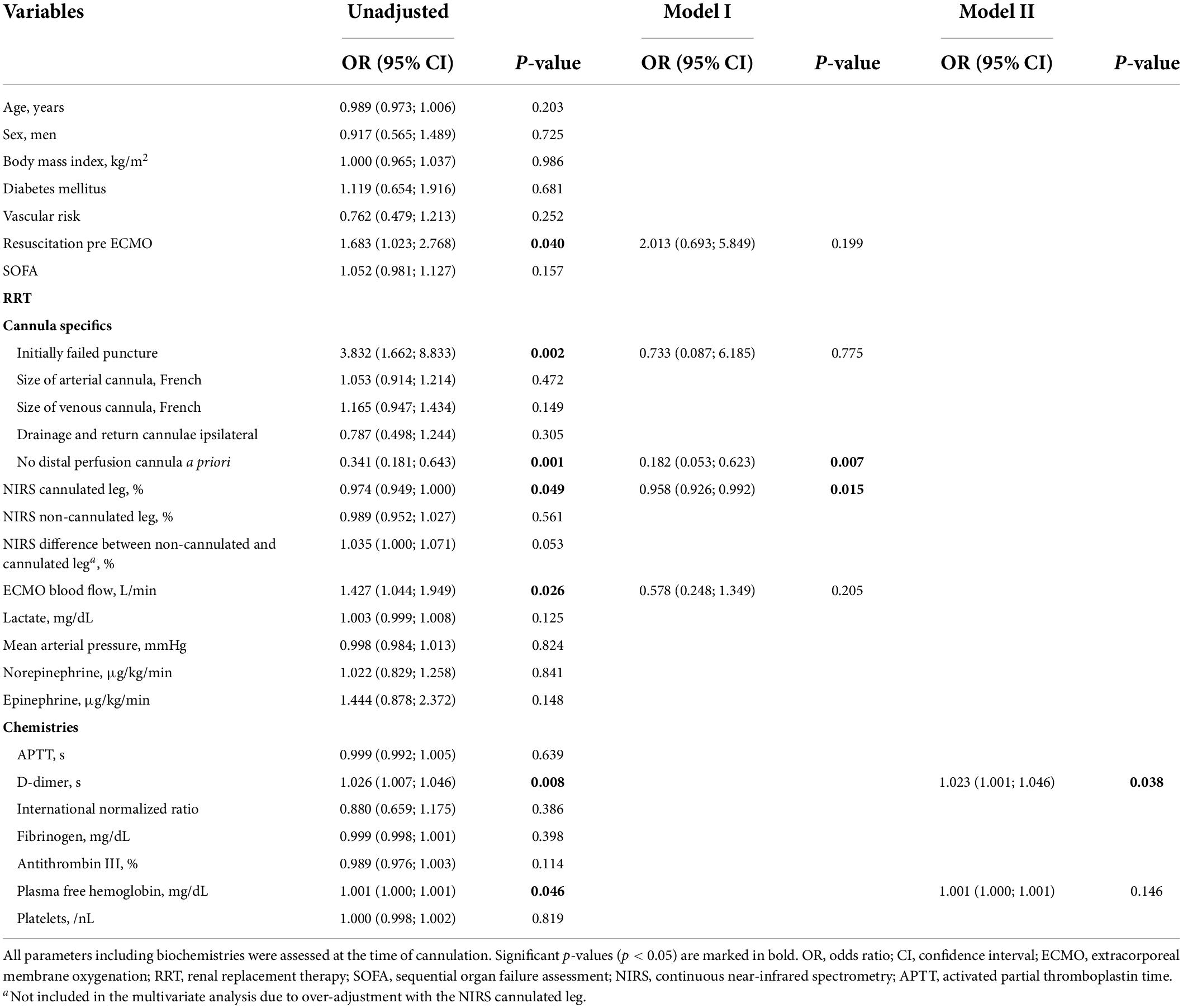
Table 4. Univariate and multivariate binary logistic regression models for limb ischemia at the time of cannulation in survivors of veno-arterial extracorporeal membrane oxygenation.
Risk factors for limb ischemia during extracorporeal membrane oxygenation support
During the entire ECMO support, patients with limb ischemia had lower median activated partial thromboplastin time (aPTT) and median NIRS values in the non-cannulated leg. Additional biochemistries, NIRS values, and vasopressors during ECMO support are provided in Supplementary Table 6. NIRS of the non-cannulated leg was associated with limb ischemia in the univariate analysis, but not in the multivariate analysis. The only factor that was associated with limb ischemia in the multivariate analysis was the lack of a DPC (Table 5).
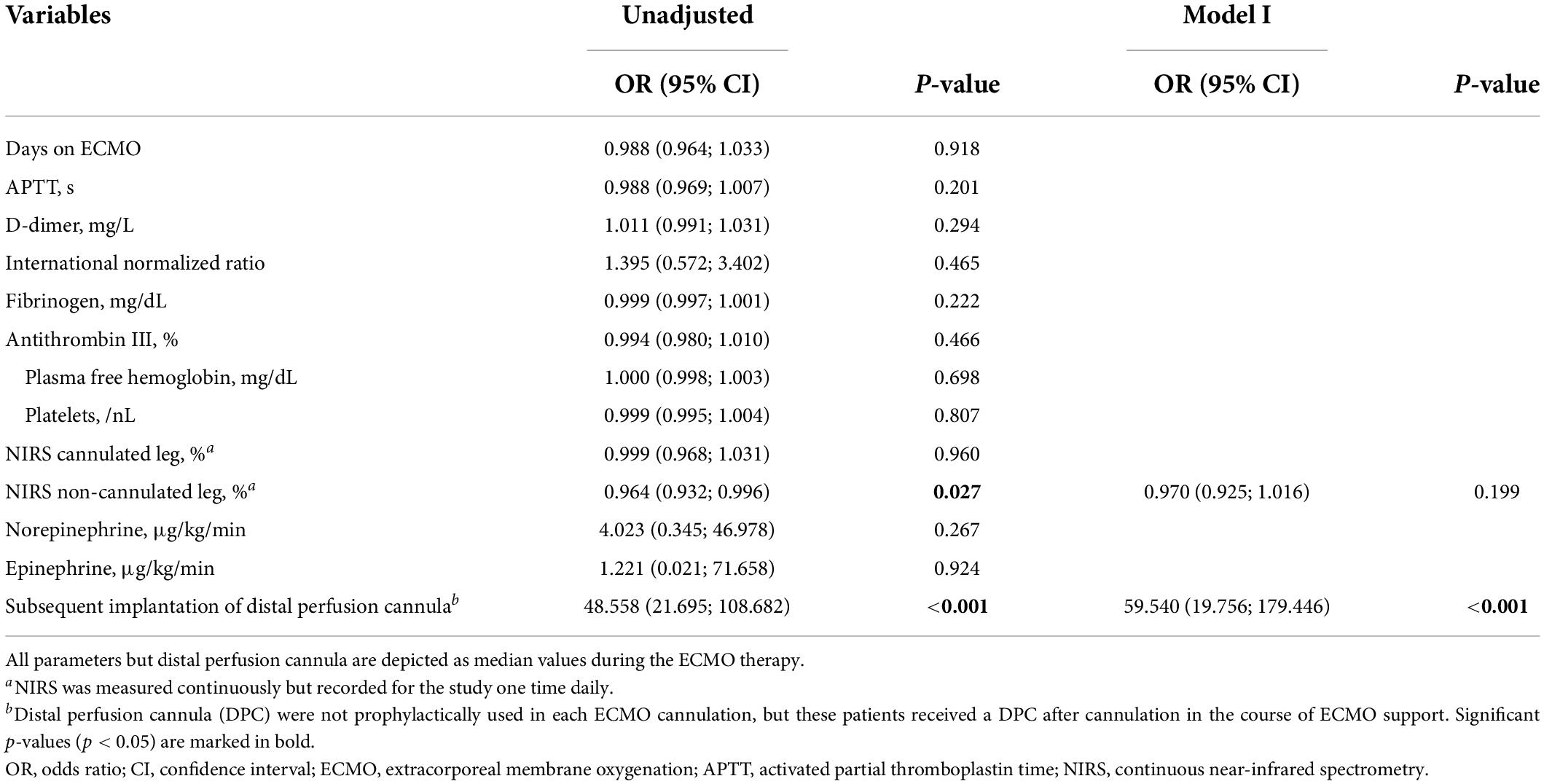
Table 5. Univariate and multivariate binary logistic regression models for limb ischemia over the entire duration of ECMO support in survivors of venoarterial extracorporeal membrane oxygenation.
Miscellaneous complications and complications associated with decannulation
Patients requiring a DPC at any time of ECMO treatment were more often diagnosed with limb ischemia, arterial thrombosis, and dissection and were in need of more packed red blood cells per day on ECMO support (Supplementary Table 7).
Initially failed puncture was seen in 6% (24/427), bleeding in 5% (20/427), and arteriovenous fistula in 0.2% (1/427). Complications in association with decannulation were observed in 17% (72/427) of patients. The most common decannulation complications were arterial thrombosis or ischemia, bleeding, and pseudoaneurysm, which were similarly distributed between percutaneous and surgical decannulation approaches (Table 6).

Table 6. Complications associated with decannulation in survivors of venoarterial extracorporeal membrane oxygenation.
Outcome
After decannulation, 71% (302/427) of patients were discharged from the hospital with good neurological outcome in 76% (229/302) of them. Survival and good neurologic outcome were lower in those with limb ischemia than in those without limb ischemia (60% [65/108] vs. 74% [237/319], p = 0.005; 67% [42/63] vs. 80% [187/233], p = 0.022; missing data of CPC in n = 6).
Discussion
This study provides novel insights into arterial and venous vascular complications in patients requiring and surviving VA ECMO. First, the prevalence of venous thrombosis was 21% and that of pulmonary embolism was 7%. The risk factor for venous thrombosis was venous jugular cannulation. Second, arterial complications were observed in 37% of patients. Risk factors for ischemia at the time of cannulation were lower NIRS of the cannulated leg and lack of a DPC. A difference of an absolute 17% in NIRS values between the non-cannulated leg and the cannulated leg showed the best predictive value for limb ischemia. Vascular complications associated with decannulation were observed in 17% of patients and were similarly distributed between percutaneous or surgical decannulation approaches.
Prevalence and risk factors for venous thromboembolism in survivors of venoarterial extracorporeal membrane oxygenation
Data on venous complications in patients requiring VA ECMO are scarce (8, 9). In an autopsy study in postcardiotomy patients by Rastan et al. (9) (n = 78), a slightly higher prevalence of venous thrombosis (32%) and pulmonary embolism (15%) was reported in comparison to 21 and 7% in the current study. Compared to previous data from our VV ECMO cohort, the prevalence of venous thrombosis in the current study with VA ECMO was considerably lower (1). Reasons for these lower rates might result from the different patient populations with less time on ECMO support, the single venous ECMO cannula access, and the higher aPTT target levels. Nevertheless, it is important to emphasize that pulmonary embolism was observed more than seven times more frequently in those with thrombosis than in those without thrombosis. These findings support the need for systematic post-decannulation ultrasound screening in patients requiring VA ECMO.
In line with the aforementioned studies (1, 9), venous thrombosis was more prevalent in the jugular cannulated than in the femoral cannulated veins. Interestingly, no difference in the rate of thrombosis was seen in bilateral compared to unilateral cannulation. Unexpectedly, the use of a small-sized venous cannula was associated with venous thrombosis. However, after correcting for body surface, the use of a small-sized venous cannula positively correlated with the diameter of the peripheral veins (10), and no association was observed anymore.
Prevalence and risk factors for arterial limb ischemia in patients requiring venoarterial extracorporeal membrane oxygenation
Frequencies of arterial complications, mainly limb ischemia, range from 2 to 52% due to different cannulation techniques and definitions of limb ischemia (11). In the current study, limb ischemia occurred in 25% of the patients and (12) was associated with mortality, as indicated in other studies. Therefore, to improve outcomes in patients on peripheral femoral VA ECMO, it is essential to detect patients at risk for limb ischemia at the time of cannulation and during the entire ECMO support. We identified lower NIRS values at the time of cannulation as an independent risk factor for the development of limb ischemia. However, the difference in NIRS values between the non-cannulated leg and the cannulated leg for limb ischemia at the time of cannulation was the best predictive value, eventually embedding the general hemodynamic status and the local perfusion of the arterially cannulated leg. Moreover, lack of a DPC, as reported by Tanaka et al. (13), and elevated D-dimers were associated with limb ischemia in contrast to unilateral compared to bilateral cannulation.
Over the entire ECMO support, only the lack of a DPC was associated with limb ischemia but not NIRS. The latter result seems to be in contrast to some smaller studies (each n < 65) (14–16); however, it can be explained by the usage of median values over the entire ECMO run without the inclusion of event-driven drops in NIRS values in case of acute ischemia. Thus, we believe NIRS monitoring to be essential to detect limb ischemia early to take immediate action to avoid severe complications.
Miscellaneous complications and complications associated with decannulation
Notably, only 24% of patients required a DPC during cannulation and 16% of them after cannulation, which is in contrast to other studies with substantially higher (>90%) DPC placement rates at the beginning of ECMO support (17). Despite that, our rate of major amputations was lower compared to other studies (17–19). In addition, it has to be taken into account that DPC might be accompanied by vascular complications itself and more bleeding due to multiple unsuccessful sticks, dislodgement, or kinking. Therefore, the decision for DPC placement should be made on an individual basis.
Complications other than limb ischemia are seldomly reported or grouped together (17, 19, 20). In particular, initially failed puncture at the site of cannulation has never been reported as a risk factor for limb ischemia. This complication is of interest because it may be avoidable by accurate identification of the vessels by applying ultrasound during cannulation. However, this association was not robust in the multivariate analysis.
Data on vascular complications in association with decannulation are lacking besides a case series comparing a percutaneous closure device with surgical decannulation reporting higher complication rates after the surgical approach (21, 22). The best method for decannulation either surgically or percutaneously is still unclear (23). In this analysis, decannulation was conducted percutaneously in more than 60% of patients with similar complication rates than with surgical decannulation. However, it is noteworthy that, irrespective of the decannulation method, limb ischemia, bleeding, and pseudoaneurysm were observed in 6, 5, and 3%, respectively. In consequence, all patients should routinely be screened after decannulation for potential complications (23).
Strength and limitations
The strength of the current study is the systematic screening for both arterial and venous complications and the inclusion of rare complications as well as of complications associated with decannulation. The exact timing of complications was limited by the applied screening strategy. The classification of risk factors for limb ischemia into those risks at the time of cannulation and risks during the entire ECMO support may help clinicians to identify patients with a high risk of limb ischemia at cannulation and during the ECMO therapy.
Due to the retrospective design, underreporting of complications may have occurred. The multivariate analysis was only carried out for the most frequent events. For the analysis over the entire ECMO support, NIRS was documented only one time per day. Patients with central VA ECMO and those with the application of a percutaneous closure device for decannulation were not included in this analysis.
Conclusion
Patients with VA-ECMO should be routinely screened for vascular complications, and necessary anticoagulation should be provided as arterial and venous complications under peripheral VA ECMO are frequently seen. A drainage cannula in the jugular vein was a risk factor for venous thrombosis and should be avoided, if possible. The placement of a DPC was necessary in 40% of patients and the decision to insert a DPC should be evaluated individually. NIRS monitoring of the cannulated and the non-cannulated leg at the time of cannulation and during ECMO is essential to identify limbs at risk for critical ischemia to allow immediate action to avoid severe complications. As complications associated with either percutaneous or surgical decannulation were equally distributed, the applied method may be chosen according to local experience and patient-specific factors.
Data availability statement
The original contributions presented in this study are included in the article/Supplementary material, further inquiries can be directed to the corresponding author.
Ethics statement
The studies involving human participants were reviewed and approved by University of Regensburg, Germany, 20-1710-104. Written informed consent for participation was not required for this study in accordance with the national legislation and the institutional requirements.
Author contributions
CF and ML were responsible for the conception, hypotheses delineation, and the design of the study, for the acquisition of data, the analysis and interpretation of this information, and for writing the article and its revision prior to submission. CF, ML, and CA were responsible for drafting the manuscript and were involved in the acquisition of data, the analysis and interpretation of this information, and the critical revision of the article prior to submission. CW, RS, MF, AP, DL, KP, CS, and TM were involved in the acquisition of data, the analysis and interpretation of results, and the critical revision of the article prior to submission. All authors contributed to the article and approved the submitted version.
Acknowledgments
We would like to thank the nursing staff of the intensive care units and the perfusionists for their excellent patient care and ECMO control.
Conflict of interest
ML was received lecture honoraria form Fresenius Medical Care.
The remaining authors declare that the research was conducted in the absence of any commercial or financial relationships that could be construed as a potential conflict of interest.
Publisher’s note
All claims expressed in this article are solely those of the authors and do not necessarily represent those of their affiliated organizations, or those of the publisher, the editors and the reviewers. Any product that may be evaluated in this article, or claim that may be made by its manufacturer, is not guaranteed or endorsed by the publisher.
Supplementary material
The Supplementary Material for this article can be found online at: https://www.frontiersin.org/articles/10.3389/fmed.2022.960716/full#supplementary-material
Abbreviations
CAD, coronary artery disease; CPC, cerebral performance category; CVD, cerebrovascular disease; DPC, distal perfusion cannula; ECMO, extracorporeal membrane oxygenation; ECPR, extracorporeal cardiopulmonary resuscitation; IU, international units; PAD, peripheral artery disease; ROC, receiver operating curve; SOFA, sequential organ failure assessment; VA, veno-arterial; VV, veno-venous.
References
1. Fisser C, Reichenbächer C, Müller T, Schneckenpointner R, Malfertheiner MV, Philipp A, et al. Incidence and risk factors for cannula-related venous thrombosis after venovenous extracorporeal membrane oxygenation in adult patients with acute respiratory failure. Crit Care Med. (2019) 47:e332–9. doi: 10.1097/CCM.0000000000003650
2. Fisser C, Rincon-Gutierrez LA, Enger TB, Taccone FS, Broman LM, Belliato M, et al. Validation of prognostic scores in extracorporeal life support: a multi-centric retrospective study. Membranes. (2021) 11:11020084. doi: 10.3390/membranes11020084
4. Lunz D, Philipp A, Müller T, Pfister K, Foltan M, Rupprecht L, et al. Ischemia-related vascular complications of percutaneously initiated venoarterial extracorporeal membrane oxygenation: indication setting, risk factors, manifestation and outcome. J Crit Care. (2019) 52:58–62. doi: 10.1016/j.jcrc.2019.04.002
5. Duff S, Mafilios MS, Bhounsule P, Hasegawa JT. The burden of critical limb ischemia: a review of recent literature. Vasc Health Risk Manag. (2019) 15:187–208. doi: 10.2147/VHRM.S209241
6. Jennett B. Assessment of outcome after severe brain damage a practical Scale. Lancet. (1975) 305:480–4. doi: 10.1016/S0140-6736(75)92830-5
7. Fisser C, Winkler M, Malfertheiner MV, Philipp A, Foltan M, Lunz D, et al. Argatroban versus heparin in patients without heparin-induced thrombocytopenia during venovenous extracorporeal membrane oxygenation: a propensity-score matched study. Crit Care. (2021) 25:160. doi: 10.1186/s13054-021-03581-x
8. Bidar F, Lancelot A, Lebreton G, Pineton de Chambrun M, Schmidt M, Hékimian G, et al. Venous or arterial thromboses after venoarterial extracorporeal membrane oxygenation support: frequency and risk factors. J Heart Lung Transplant. (2021) 40:307–15. doi: 10.1016/j.healun.2020.12.007
9. Rastan AJ, Lachmann N, Walther T, Doll N, Gradistanac T, Gommert JF, et al. Autopsy findings in patients on postcardiotomy extracorporeal membrane oxygenation (ECMO). Int J Artif Organs. (2006) 29:1121–31.
10. Kröger K, Ose C, Rudofsky G, Roesener J, Weiland D, Hirche H. Peripheral veins: influence of gender, body mass index, age and varicose veins on cross-sectional area. Vasc Med. (2003) 8:249–55. doi: 10.1191/1358863x03vm508oa
11. Yang F, Hou D, Wang J, Cui Y, Wang X, Xing Z, et al. Vascular complications in adult postcardiotomy cardiogenic shock patients receiving venoarterial extracorporeal membrane oxygenation. Ann Intens Care. (2018) 8:72. doi: 10.1186/s13613-018-0417-3
12. Gulkarov I, Bobka T, Elmously A, Salemi A, Worku B, Gambardella I, et al. The effect of acute limb ischemia on mortality in patients undergoing femoral venoarterial extracorporeal membrane oxygenation. Ann Vascul Surg. (2020) 62:318–25. doi: 10.1016/j.avsg.2019.06.012
13. Tanaka D, Hirose H, Cavarocchi N, Entwistle JW. The impact of vascular complications on survival of patients on venoarterial extracorporeal membrane oxygenation. Ann Thorac Surg. (2016) 101:1729–34. doi: 10.1016/j.athoracsur.2015.10.095
14. Patton-Rivera K, Beck J, Fung K, Chan C, Beck M, Takayama H, et al. Using near-infrared reflectance spectroscopy (NIRS) to assess distal-limb perfusion on venoarterial (V-A) extracorporeal membrane oxygenation (ECMO) patients with femoral cannulation. Perfusion. (2018) 33:618–23. doi: 10.1177/0267659118777670
15. Wong JK, Smith TN, Pitcher HT, Hirose H, Cavarocchi NC. Cerebral and lower limb near-infrared spectroscopy in adults on extracorporeal membrane oxygenation. Artif Organs. (2012) 36:659–67. doi: 10.1111/j.1525-1594.2012.01496.x
16. Kim DJ, Cho Y-J, Park SH, Lim C, Park K-H, Jheon S, et al. Near-infrared spectroscopy monitoring for early detection of limb ischemia in patients on veno-arterial extracorporeal membrane oxygenation. ASAIO J. (2017) 63:613–7. doi: 10.1097/MAT.0000000000000532
17. Danial P, Hajage D, Nguyen LS, Mastroianni C, Demondion P, Schmidt M, et al. Percutaneous versus surgical femoro-femoral veno-arterial ECMO: a propensity score matched study. Intens Care Med. (2018) 44:2153–61. doi: 10.1007/s00134-018-5442-z
18. Gulkarov I, Khusid E, Worku B, Demissie S, Guerges M, Salemi A, et al. Meta-analysis of the effect of vascular complications on mortality in patients undergoing femoral venoarterial extracorporeal membrane oxygenation. Ann Vascul Surg. (2021) 71:488–95. doi: 10.1016/j.avsg.2020.09.042
19. Avalli L, Sangalli F, Migliari M, Maggioni E, Gallieri S, Segramora V, et al. Early vascular complications after percutaneous cannulation for extracorporeal membrane oxygenation for cardiac assist. Minerva Anestesiol. (2016) 82:36–43.
20. Aziz F, Brehm CE, El-Banyosy A, Han DC, Atnip RG, Reed AB. Arterial complications in patients undergoing extracorporeal membrane oxygenation via femoral cannulation. Ann Vascul Surg. (2014) 28:178–83. doi: 10.1016/j.avsg.2013.03.011
21. Shah A, Ghoreishi M, Taylor BS, Toursavadkohi S, Kaczorowski DJ. Complete percutaneous decannulation from femoral venoarterial extracorporeal membrane oxygenation. JTCVS Techniq. (2021) 6:75–81. doi: 10.1016/j.xjtc.2020.11.005
22. Majunke N, Mangner N, Linke A, Boudriot E, Erbs S, Tietz F, et al. Comparison of percutaneous closure versus surgical femoral cutdown for decannulation of large-sized arterial and venous access sites in adults after successful weaning of veno-arterial extracorporeal membrane oxygenation. J Invasive Cardiol. (2016) 28:415–9.
Keywords: ECMO, vascular complication, ischemia, thrombosis, decannulation, bleeding, NIRS, risk factor
Citation: Fisser C, Armbrüster C, Wiest C, Philipp A, Foltan M, Lunz D, Pfister K, Schneckenpointner R, Schmid C, Maier LS, Müller T and Lubnow M (2022) Arterial and venous vascular complications in patients requiring peripheral venoarterial extracorporeal membrane oxygenation. Front. Med. 9:960716. doi: 10.3389/fmed.2022.960716
Received: 03 June 2022; Accepted: 08 July 2022;
Published: 28 July 2022.
Edited by:
Guo-wei Tu, Fudan University, ChinaReviewed by:
Warwick Wolf Butt, Royal Children’s Hospital, AustraliaSuguru Ohira, Westchester Medical Center, United States
Copyright © 2022 Fisser, Armbrüster, Wiest, Philipp, Foltan, Lunz, Pfister, Schneckenpointner, Schmid, Maier, Müller and Lubnow. This is an open-access article distributed under the terms of the Creative Commons Attribution License (CC BY). The use, distribution or reproduction in other forums is permitted, provided the original author(s) and the copyright owner(s) are credited and that the original publication in this journal is cited, in accordance with accepted academic practice. No use, distribution or reproduction is permitted which does not comply with these terms.
*Correspondence: Christoph Fisser, Q2hyaXN0b3BoLkZpc3NlckB1a3IuZGU=
 Christoph Fisser
Christoph Fisser Corina Armbrüster1
Corina Armbrüster1 Lars S. Maier
Lars S. Maier